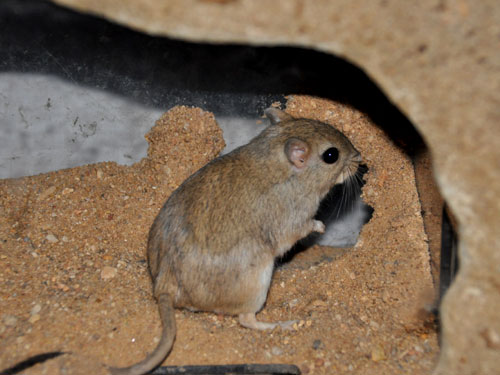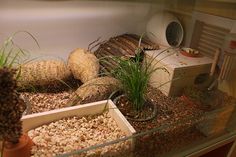General Information:
Mongolian gerbils are by far the most commonly kept pet jird. For that reason, we wrote a Mongolian gerbil care guide dedicated to only them. We wanted to further expand on jird care, as there are other jirds in the exotic pet trade; Persian jirds, Shaws jirds, Tristrams jirds, , Libyan jirds, and Sundevals jirds. All of the listed jirds belong to the genus Meriones - this is the classification we're discussing in this care guide.
Fun fact:
Not all gerbils are jirds, but all jirds are gerbils. Gerbils and Jirds have different phenotypic differences. There are over 90 recognised species of gerbils!
Meriones jirds are found in localities ranging from Africa to Mongolia. They're burrowing rat-like rodents and live in often complex burrows. They commonly inhabit desert regions.
As pets, if you're looking to keep jirds other than the Mongolian gerbil (Meriones unguiculatus), then you must be aware that many jirds are often much larger and more difficult to handle as they're very active and have an incredible leap.
Most jirds are omnivores, but their diets can vary. Some jirds consume more protein than other similar species, whereas others consume more seeds.
Active-cycles and socialisation also varies considerably between species.
Care:
Housing/Enrichment:
Almost all jirds are burrowing rodents and avid chewers. Keepers usually recommend keeping jirds in large glass tanks that allow them to carry out natural behaviours. Depending on the jird, tank sizes can range from 4ft-8ft (if not larger). This is usually based on either the size of the jird, or how complex and large their habitats are in the wild. Researching about their wild habitat and behaviour can help inspire you with cage and enrichment decisions.
Some jirds are incredibly intelligent too, so you must supply plenty of enrichment. It's generally advised to avoid plastic toys and cages because most jirds are relentless chewers.
Ensure they have access to sand baths, wooden toys, branches, and some individuals will utilise a solid-floored wheel.
Mongolian gerbils are by far the most commonly kept pet jird. For that reason, we wrote a Mongolian gerbil care guide dedicated to only them. We wanted to further expand on jird care, as there are other jirds in the exotic pet trade; Persian jirds, Shaws jirds, Tristrams jirds, , Libyan jirds, and Sundevals jirds. All of the listed jirds belong to the genus Meriones - this is the classification we're discussing in this care guide.
Fun fact:
Not all gerbils are jirds, but all jirds are gerbils. Gerbils and Jirds have different phenotypic differences. There are over 90 recognised species of gerbils!
Meriones jirds are found in localities ranging from Africa to Mongolia. They're burrowing rat-like rodents and live in often complex burrows. They commonly inhabit desert regions.
As pets, if you're looking to keep jirds other than the Mongolian gerbil (Meriones unguiculatus), then you must be aware that many jirds are often much larger and more difficult to handle as they're very active and have an incredible leap.
Most jirds are omnivores, but their diets can vary. Some jirds consume more protein than other similar species, whereas others consume more seeds.
Active-cycles and socialisation also varies considerably between species.
Care:
Housing/Enrichment:
Almost all jirds are burrowing rodents and avid chewers. Keepers usually recommend keeping jirds in large glass tanks that allow them to carry out natural behaviours. Depending on the jird, tank sizes can range from 4ft-8ft (if not larger). This is usually based on either the size of the jird, or how complex and large their habitats are in the wild. Researching about their wild habitat and behaviour can help inspire you with cage and enrichment decisions.
Some jirds are incredibly intelligent too, so you must supply plenty of enrichment. It's generally advised to avoid plastic toys and cages because most jirds are relentless chewers.
Ensure they have access to sand baths, wooden toys, branches, and some individuals will utilise a solid-floored wheel.
Socialising:
Some jirds can become very well accustomed to their handlers/owners. Be sure to handle them with care as most jirds have a powerful bite. In our experience, few wish to bite you. It is also important as an owner of a particularly exotic pet that you're able to monitor them for any changes in behaviour and ensure you have a suitable veterinarian to hand. It's vital your veterinarian is exotic savvy and has an interest in the animal being treated.
Socialising with other jirds depends entirely on the type of jird you're keeping. It's important you thoroughly research if your desired species of jird can cohabit. Some species can or can't cohabit depending on gender, so you must be very confident that you know what you're doing.
As mentioned above, they have a powerful bite, and they also have sharp claws. Cohabiting solitary jirds is extremely dangerous for individuals.
Diet:
Jirds are omnivores, meaning they require both plant and animal materials to stay healthy. You must be aware of your jirds native diet. Some individuals may require more protein to stay healthy, whereas others have a predominantly seed and grain-based diet.
Please feel free to ask more questions.
Some jirds can become very well accustomed to their handlers/owners. Be sure to handle them with care as most jirds have a powerful bite. In our experience, few wish to bite you. It is also important as an owner of a particularly exotic pet that you're able to monitor them for any changes in behaviour and ensure you have a suitable veterinarian to hand. It's vital your veterinarian is exotic savvy and has an interest in the animal being treated.
Socialising with other jirds depends entirely on the type of jird you're keeping. It's important you thoroughly research if your desired species of jird can cohabit. Some species can or can't cohabit depending on gender, so you must be very confident that you know what you're doing.
As mentioned above, they have a powerful bite, and they also have sharp claws. Cohabiting solitary jirds is extremely dangerous for individuals.
Diet:
Jirds are omnivores, meaning they require both plant and animal materials to stay healthy. You must be aware of your jirds native diet. Some individuals may require more protein to stay healthy, whereas others have a predominantly seed and grain-based diet.
Please feel free to ask more questions.



